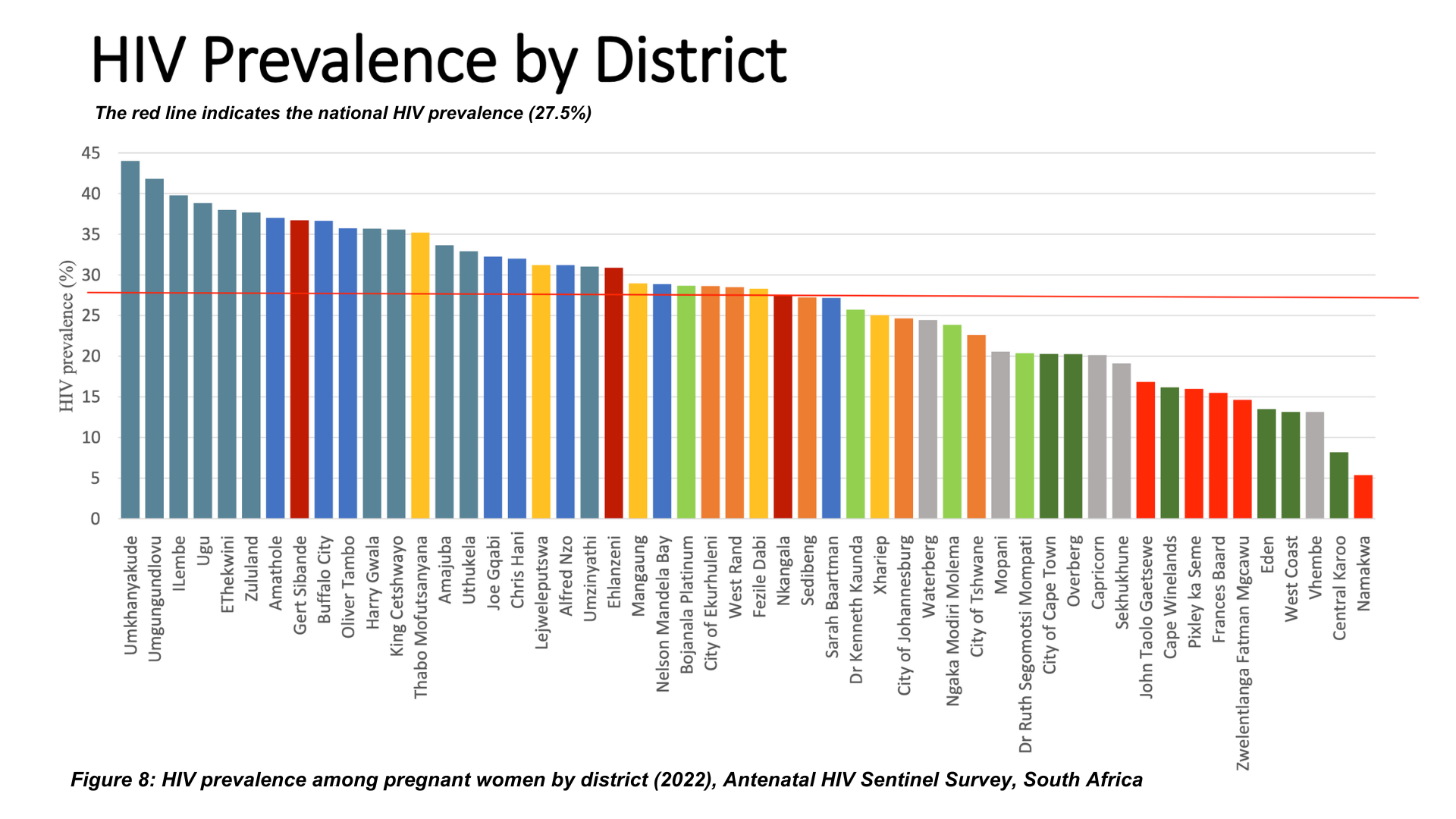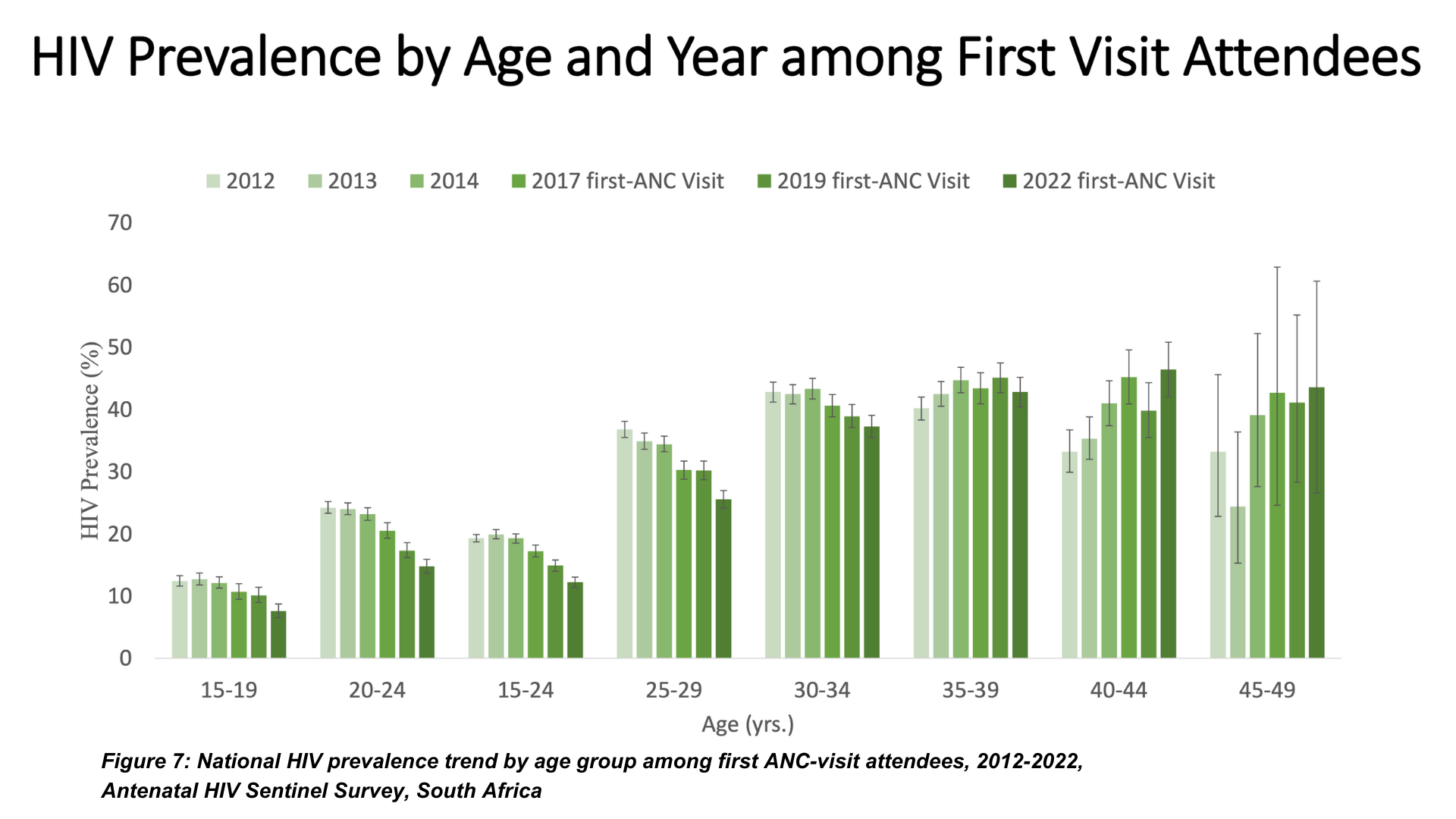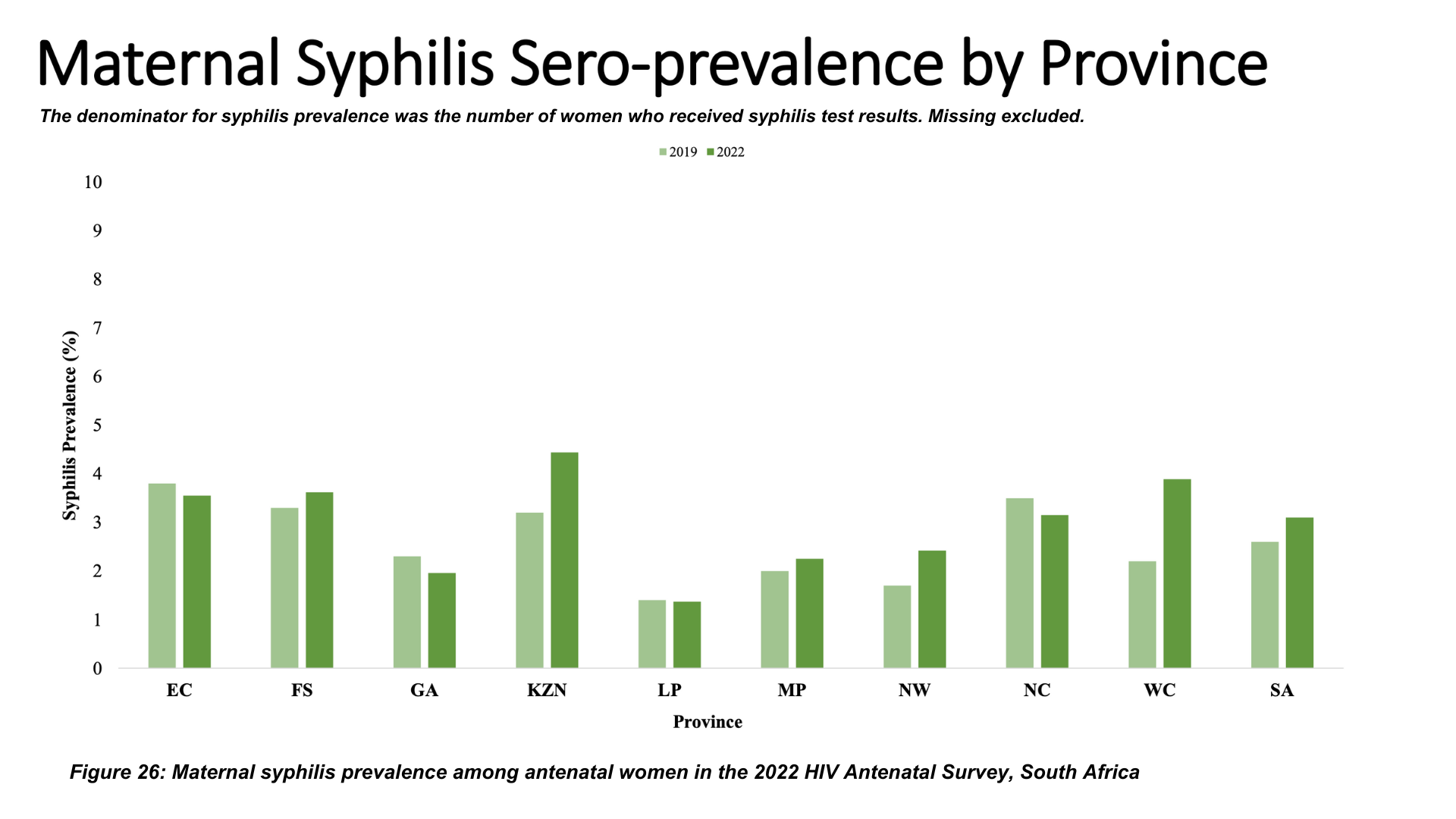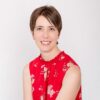- Every second year, South Africa releases a national antenatal HIV survey, which looks at the proportion of pregnant women who are HIV-positive and have syphilis.
- The latest report, released at the end of last year, shows that fewer pregnant women have HIV.
- Although the prevalence of HIV dropped by only 2.5% from levels in 2019, the downward trend means we could be making steady progress to having a generation born HIV-free.
- In the first of a three-part series, we help you make sense of the survey’s results and what it means for the country’s HIV outlook.
In today’s newsletter Linda Pretorius walks you through South Africa’s latest antenatal HIV numbers. Sign up today.

Every second year, South Africa releases a national antenatal HIV survey, which looks at the proportion of pregnant women who are HIV-positive and have syphilis.
The nationwide study in which the number of pregnant women with HIV visiting government clinics for their pregnancy check-ups is counted has been run every year between 1990 and 2015, and every second year since 2017. The results are published by the National Institute for Communicable Diseases.
Surveying pregnant women is a smart move, because they’re sexually active and so the picture becomes somewhat of a proxy for what the country’s state of HIV infections look like.
The latest survey, the 2022 antenatal report, shows that, overall, fewer pregnant women have contracted HIV — down from 30% in 2019 (when the previous survey was done) to 27.5% in 2022. But more pregnant women between 40 and 49 years old are infected with the virus now than in 2019.
The 2022 survey tested the blood samples of about 38 000 women.
So what do those results really mean and what do provincial pictures look like? In the first of a three-part series on the results of the survey, we help you make sense of it. (The second part will look at how South Africa is doing with reaching the United Nations 95-95-95 goals).
1. Is a study like this a good snapshot of what’s happening in South Africa?
Yes. The type of granular insight into what the HIV profile of pregnant women — and by extension, the outlook for an Aids-free future for children — is only possible with large surveys like this being done regularly and with a solid statistical design. Running a nationwide analysis like this at antenatal clinics is therefore a convenient way to get access to a good-sized sample.
In the most recent count, nurses at state clinics took blood samples from 37 828 pregnant women between 15 and 49 years old, across all 52 of South Africa’s health districts from late February to early April in 2022. (Originally the survey would have run from October to November in 2021, but COVID derailed the plans, and so it had to be pushed out to the next year.) Women were also asked to complete a questionnaire with questions about their age, schooling, previous pregnancies and what their relationship with their baby’s father was. Most participants were from KwaZulu-Natal (KZN), with the fewest coming from Gauteng. About half of the women were in the age group 20–29.
2. How have HIV infections changed over time?
HIV prevalence among pregnant women has been hovering around the 30% mark since 2005. It’s the first time in almost two decades that the overall trend seems to be turning down.

A drop of 2.5% may not sound like much, but translated into real numbers it paints a different picture.
In 2019, when the last survey was conducted, 34 281 women participated. Of them, 30% were HIV infected, which works out to about 10 280 people.
In the latest survey, though, 37 828 women were tested. A prevalence of 27.5% means that a similar number — about 10 400 — tested positive. But overall it’s around 1 060 fewer moms with infections — which means more children are born HIV free.
However, it’s when scaling these numbers beyond the sample that the significance of the drop really hits home.
In 2022, just under 1-million babies were born in South Africa. Studies show that, without treatment, between 15% and 45% of babies contract the virus from their moms either in the womb or during birth or breastfeeding. So if fewer moms had HIV than in 2019 to start with, it means fewer children — up to about 11 000 — would’ve had to be put on antiretrovirals (ARVs), along with their moms, that year and kept up for the rest of their lives.
A 2019 analysis showed that it cost the state around R3 300 to keep one adult on ARVs a year, and about R3 800 for a child’s treatment then. So, having significantly fewer people who need treatment means there’d be more money in the budget to channel to other public health issues.
3. Where are the hot spots?
HIV infection among pregnant women isn’t equally common across South Africa. For example, in KZN, 37% of the patients at antenatal clinics tested positive, with a similar proportion (33%) in the Eastern Cape. On the other hand, only about 15 out of every 100 women from the Northern Cape were infected.
Although the numbers in KZN and the Eastern Cape still seem high, they’ve both come down significantly from 2019. In fact, the number of positive cases has dropped in all provinces since the last survey — the most in the Northern Cape (which had the fewest infections in the first place).
At a district level, only nine of 52 districts saw infections going up from 2019 figures.
At 44%, the highest HIV prevalence — that is, the proportion of infections among the group tested — was in the uMkhanyakude district in KZN. This is a rural area spanning from the Umfolozi River near Mtubatuba to the border with Eswatini and Mozambique in the north. Along with uMkhanyakude, six other districts in this province were among the 10 with the most HIV infections.

KZN has traditionally been the province hardest hit by HIV in South Africa, which is why researchers in other studies say focusing on getting people onto ARVs here — and making sure they stay on the medication — is the best way to bring infections down in this province.
The trends seen in this survey suggest that efforts to curb the spread of HIV — whether through promoting safe sex, prodding people to find out their status or getting those with HIV onto antiretroviral treatment soon after they’re diagnosed, as outlined in the country’s blueprint to fight HIV — are starting to pay off.
4. Are the number of infections different by age group?
Fewer HIV infections were seen among younger moms (up to 34 years old). Further good news is that numbers have been steadily coming down over the last 10 years, suggesting that efforts to increase awareness and limit the spread of HIV among the younger generation might be paying off. And if we keep that up, it looks like the trend will carry on.
But for the age groups from 35 years and up, things look different. HIV prevalence among women between 35 and 39 years old has been hovering somewhere between 40% and 45% for a decade. From 40 years and up, though, the number of moms with HIV has been steadily rising over the past 10 years.

But even in that there’s good news.
Because if we see a delayed effect of measures to clamp down on the virus, it means that the drops seen in the younger age groups will change the HIV profile of South Africa’s moms and their children over the next decade if we keep up the efforts to stop HIV from spreading — and so help the country to work towards the goal of ending Aids by 2030.
5. Why were women also tested for syphilis?
Just over 97% of expecting moms were screened for syphilis, as the World Health Organisation recommends. Results show that about 3% of pregnant women were infected, with most coming from KZN.

Syphilis, a bacterial infection, spreads when someone has skin-to-skin contact with a genital sore caused by the germ, like during unprotected sex, or when an infected mother passes it on to her unborn child.
The number of infections is up one percentage point since 2015, which, the report warns, means that public health efforts should do more to help stop sexually transmitted infections (STIs) from spreading among pregnant women and their partners, such as by testing and treating people early and encouraging men to be circumcised. Looking into making doxycycline, a type of antibiotic which studies show can significantly lower bacterial STIs, available to protect someone from getting infected in the first place can also help, the report says.
When a pregnant woman passes syphilis on to her child, it can result in stillbirth or a baby being born too early and weighing too little, which means they’d need extra care after birth or not develop as well as other children. It can also harm the baby’s brain, eyes, hearing and nervous system.
Testing pregnant women for syphilis means they can get treated with antibiotics soon enough and so help keep their baby healthy — and lower the potential load on the public health system. Almost all the women (around 97%) who tested positive for syphilis in the survey were treated.
But testing — and treating — pregnant women for syphilis has an added benefit.
Having syphilis can make it at least twice as easy for someone to contract HIV and at the same time make it harder for them to fight an existing HIV infection and get their viral load down. So, if syphilis is cleared up, HIV won’t be able to get a foothold so easily either. In this way, the spread of HIV can be slowed down even further.
Linda Pretorius is Bhekisisa’s content editor. She has a PhD in biosystems from the University of Pretoria has been working as a science writer, editor and proofreader in the book industry and for academic journals over the past 15 years. At Bhekisisa she helps authors to shape and develop their stories to pack a punch.





